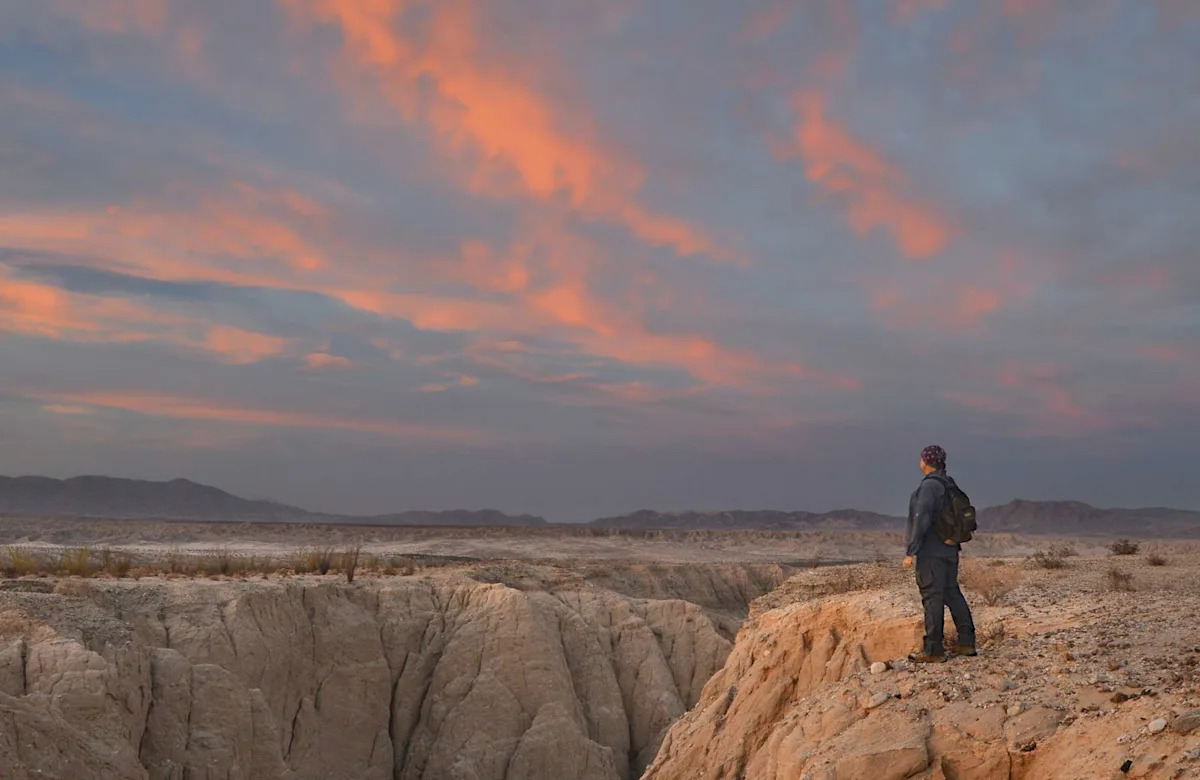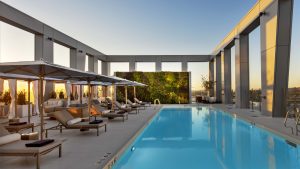The human body, I found out recently, is a heavy-metal concert, if you get the opportunity to really hear it.
One morning last June, an hour past sunrise, I visited one of the quietest places on earth. I was in southern California, in Anza-Borrego Desert State Park, about 50 miles northeast of San Diego. I had wandered off the trail to climb a group of brown and red boulders. At the top, I lay down on my back, in what felt like complete silence. A few minutes later, I began to notice the sounds emanating from my own body. A cup of coffee sloshing around my stomach. The whoosh of blood circulating around my skull. After 15 minutes, what sounded like a helicopter flew over my shoulder. It turned out to be a hummingbird, which began hovering three feet from my face, the sound of its wings almost comically loud.
Anza-Borrego is the largest state park in California, covering more than 600,000 acres. And while it’s not exactly off the grid, its sheer size makes it possible to explore for days without seeing another visitor. In September 2024, it was granted a Quiet Conservation Area award by Quiet Parks International, a nonprofit dedicated to identifying and preserving the world’s least noisy corners.
Though I’ve lived in southern California for more than a decade, I hadn’t heard of Anza-Borrego until news of the designation percolated into my social media feed. I immediately wanted to experience it for myself. Daily life in my corner of Los Angeles is nonstop noise. There’s the expected road traffic and leaf blowers, plus the rumble of helicopters and fire trucks. On top of that, I often walk around my neighborhood wearing headphones and listening to music, replacing the background racket with the sounds I prefer. No wonder I’ve found myself craving silence. I imagined a visit to a quiet park being a form of self-care.
I quickly hatched a plan to visit Anza-Borrego in the company of Matt Mikkelsen, a board member of Quiet Parks International, hoping that he could help me understand the organization’s work. An audio engineer and “sound recordist,” Mikkelsen has been to the park many times and was part of the team that originally surveyed it with advanced equipment to determine its least noise-polluted spots. We agreed to meet up and spend a day—and night—seeking out silence together.
My drive to Anza-Borrego from L.A. was typical of southern California: on-and-off midday traffic while I crossed the urban-to-suburban zone, heading south. As I turned east, climbing up out of San Diego, the rush of traffic started to fall away. The terrain transitioned to a blend of forest and hills. My ride was already uncharacteristically quiet: Ford is a sponsor of Quiet Parks, and the company had offered to lend me a Ford F-150 Lightning for the journey. Its electric drivetrain was practically silent.
Mikkelsen and I met for dinner that evening at the Fox Bistro, a restaurant in Borrego Springs, a tiny desert town on the floor of the Borrego Valley that’s completely surrounded by the park. Over club sandwiches and some very good margaritas, Mikkelsen described Anza-Borrego as an under-the-radar oasis that’s known among devotees for its wildflower blooms and hiking trails, as well as its golden eagles and herds of bighorn sheep. But, unsurprisingly, his favorite aspect of the place is its profound quietness. “My whole demeanor changes when I’m there,” he said. “Physically, I feel more relaxed, and mentally, I just soften.”
After a comfortable night’s sleep at La Casa Del Zorro Desert Resort & Spa, a low-key oasis in Borrego Springs with casitas, swimming pools, and tennis and pickleball courts, Mikkelsen and I met before sunrise the next morning. As we approached the park, the mountains in front of us started to flicker with orange and yellow alpenglow. Before long, Mikkelsen instructed me to pull off the road. We were situated in an immense valley peppered with boulders and desert agave plants—the site, Mikkelsen told me, of a winter village of the Kumeyaay people, who have inhabited the region for more than 10,000 years. He pointed out a number of morteros, bowl-shaped holes in the boulders formed over many years by Indigenous people pounding and grinding wild seeds and beans.
As the sun continued to rise behind us, Mikkelsen pulled out some of his audio equipment: a pair of highly sensitive microphones attached to a decibel meter. He measured a long interval and determined an average sound level of 26 decibels. That’s about as quiet as the ticking of a watch.
Which explains how I later came to find myself lying in utter quietude, getting startled by a hummingbird.
Interestingly, Mikkelsen and his Quiet Parks peers don’t consider sounds like the flapping of hummingbird wings to be “noise.” That’s because they differentiate between sounds that are native to a place and those that aren’t. “There are the obvious things like airplanes, cars, trains, resource extraction,” he explained. “But if you had cattle grazing here, well, cattle are not native to this area, so that could also be considered noise pollution. You can get philosophical with it pretty quickly.” He told me about a visit he’d made to the Amazon Basin: though it was riotous with animal calls and other sounds, it was, in terms of audio pollution, absolutely pristine.
I wandered off toward a gigantic palm tree, and in the shade of its canopy, I closed my eyes and breathed deeply. Something about all that quiet prompted me to meditate—nothing formal, just 10 minutes alone in the hush. I felt the most relaxed I’d been in weeks.
The day was starting to heat up, so we returned to La Casa Del Zorro and its blissful pools. Later, after a dinner of carne asada nachos at Carmelita’s Mexican Grill, we decided to head out for some stargazing. We drove to a dried-out lake bed in the valley. There was nobody around, and the only sound was the whisper of the wind. Stars began to emerge. Neither of us said a thing: no words could do justice to the immensity of the experience of it all.
Where Quiet Reigns
Anza-Borrego Desert State Park
Covering a massive sweep of southern California, this park is home to endangered bighorn sheep and a host of other desert species, as well as ancient rock art.
Boundary Waters Canoe Area Wilderness
This million-acre Minnesota landmark has 1,200 miles of canoe routes, more than 2,000 official campsites, and zero motorized vehicles.
The first “Urban Quiet Park” in the U.S. rests atop an extinct volcano in Portland that’s now populated by mature Douglas firs and is popular with photographers thanks to its skyline views.
Niobrara National Scenic River
Its 76-mile course through northern Nebraska was the first “Quiet Trail” in the U.S. to be recognized by Quiet Parks International. Visitors can float downstream in engineless watercraft or hike through the six ecosystems that converge on the river.
A Texas Hill Country escape that’s just 20 miles southwest of Austin, this family-owned 6,600-acre ranch hosts public programs including bird-watching tours that spotlight species like the endangered golden-cheeked warbler.
A version of this story first appeared in the November 2025 issue of Travel + Leisure under the headline “The Silent Treatment.”
Read the original article on Travel & Leisure




